Looking after the family: a study of children looked after in kinship care in Scotland
Study commissioned by the Social Work Services Inspectorate, now the Social Work Inspection Agency.
3 The kinship children and their families
Coming to stay with my granddad is a good thing.
This chapter outlines the circumstances of the 30 children in the study, including their ages, gender and legal status. It looks at reasons why they are being looked after, how they came to their placements and how long they have been with their kinship families. The chapter outlines the circumstances, health and finances of the carer families, including the relationship of carers to the child, carers' ages and the structures of households in which children were living, and the chapter ends by looking at the well-being of children and their education. Throughout the chapter, relevant comparisons are made between the findings from this study and those from previous research.
Who are the children in the study?
The 30 children comprised 17 females and 13 males. All the children were white and had been born in the UK. They ranged from eight to 16 years of age. It is important to emphasise that the children here are not representative of all children looked after in kinship care. As will be shown below, the majority had been in their placements for a large part of their childhoods, undoubtedly something which influenced the views of both children and their carers.
Kinship children's birth families
Twenty-six children had birth mothers who were still alive. Twenty-eight children had fathers who were alive but, as Chapter 5 will show, not all were in contact with their children. Only one child had neither a mother nor a father.
Chart 3.1 Whereabouts of siblings
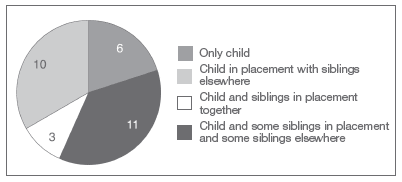
Chart 3.1 shows the whereabouts of siblings. Six of the 30 children were only children. Three children were in their placements with all their siblings. Eleven were living on their own in the placement and had siblings living elsewhere. Of these 11, four children had siblings living with their birth mother and, in three of these cases, the siblings were from new partnerships. Two children had siblings living with their step fathers. One child's sibling was in a secure unit, another child's sibling was in another kinship placement, one child had two siblings who were in foster care and awaiting adoption while the final child in this category did not know the whereabouts of his/her sibling.
Ten of the children studied were living with some of their siblings and had siblings elsewhere. Four children had siblings living with their birth mother, two of which were from new partnerships. Two children's siblings had been adopted, another two children's sibling were in a different kinship placement and two children did not know the whereabouts of their siblings
Legal status
Chart 3.2 The Legal Status of the kinship children

Chart 3.2 shows that, across the five local authorities, four-fifths of the children were the subject of a supervision requirement under section 70 of the Children (Scotland) Act 1995. Four children were in placements where carers held parental responsibility under section 11 of the Children (Scotland) Act 1995, one child was accommodated under section 25 of the Children (Scotland) Act 1995. One child was receiving occasional family support within section 22 of the Children (Scotland) Act but had previously been the subject of a section 70 supervision requirement within the Children (Scotland) Act 1995.
Reasons for placement
Chart 3.3 The reasons for the kinship placement
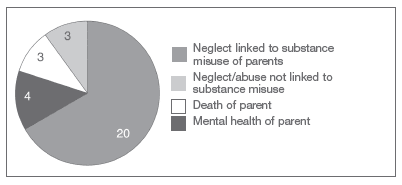
In all our cases, children had come to their placements because their parents were unable to look after them. Of the three children who had come to the placement because of the death of their mothers, two had been living in step parent households. Their stepfathers were willing to take their biological children but not the kinship child. Twenty children came to the placements primarily because of parents' substance misuse, which had resulted in their neglect. The substance misuse concerned drugs, but there were those whose functioning had been seriously affected by alcohol misuse. Several parents had been affected by both drugs and alcohol. These findings are supported by other studies (for example, Laws 2001), which also found that substance misuse of parents was a major cause of child neglect and other forms of abuse, and led to children being placed in kinship care.
Four children came to their placements because they had been physically abused or neglected by their parent, where there was no connection to substance misuse. Three children had parents with serious mental health problems, which led to children's neglect. The pattern of reasons in this study reflects that found in other studies, both in the USA and UK (see Hunt 2001).
Who initiated the placement?
There were three different routes by which children came to their placements. In the first, which occurred in eight cases, carers took emergency action because they were concerned about the child's safety. They took the initiative and removed the child from danger and took the child home with them. The majority then contacted social work services. In one case, a grandmother visited her daughter, who was incapacitated through drug abuse, and found the children dirty, neglected and exposed to an open fire. The grandmother simply told the daughter she was taking the children home with her:
The children were running about naked and there's an electric fire and there were clothes hanging on the electric fire and the wee yin had switched the fire on, so I just lifted the kids and took them. I've had them ever since.
In another case, a single parent died unexpectedly and the carer stepped in and took the child home.
In the second route, by which nine children came to their placements - usually in a crisis - social work departments had contacted carers and asked them to take the child. In one case, the social worker intervened because the child was not going to school and asked the grandmother to look after the child:
It was one day I knew she [daughter] smoked hash and everything like that but then one day she came in, she went "I've started taking heroin", and well, that was it but then Peter was in nursery and she was never going down to pick him up. The police were having to come up here to get us to go to the nursery and collect him and until it got to the point, the social work department just said, "enough's enough".
In another case, a mother's mental health had deteriorated to the state where she could not look after the children. The social worker approached the carer and, in the carer's words 'begged' the carer to take the children. The social worker promised substantial financial help and support, a promise which the carers felt had not been fulfilled. In a third case, a child who had been removed from his family home and placed in residential care initiated the placement by asking if he could go to his grandmother's home.
In the third route (13 cases) children's placements were arranged by mutual agreement between the child, the carer, the parents and sometimes the social worker, including five cases where parents asked carers to look after their children. Either the parents had erratic lifestyles due to substance misuse or were suffering from serious mental health problems:
… and they were going to put them into care and they did put them to care. So I said just keep them there till we get there. I decided, and my daughter agreed, I would take them because my daughter worked and I worked as well actually, and I gave up the job to take them.
… my sister phoned me in tears, she said "look, could you take him" and I said "Well, yes I can, cause I've got a spare room, but you'll have to ask the social worker obviously". So the next night, I got a phone call from Sheila, Stewart's social worker, saying was I seriously thinking of taking Stewart. "Of course", I said, he didn't want him to go back in care at all.
In two cases, carers had to actively negotiate with the social work department to persuade them that the children should come to live with them. Both these cases raised the issue of how grandparents and other relatives are not automatically seen as having any say in the child's upbringing. In one case, a child who had a serious medical problem had missed clinical appointments over a substantial period due to the neglect by the mother.
By contrast, there were examples of carefully planned placements where social workers had undertaken rigorous assessments of the carers. There was also evidence that the transition to the placement had been well planned, with children being able to have trial weekends before moving in permanently. In at least two cases, there was evidence of excellent social work practice reported by carers, where the social worker had consulted all members of the family, including the parents. The worker had then gradually eased the children into the placement, while providing intensive support and, as the children had settled, had reduced their intervention to a level which was mutually agreed with children and carers.
The issue of how children came to their placements raises some concerns about social work practice. In emergency placements, the social worker had no time to assess the family. They were informed after the child had been placed and faced the uncomfortable decision of having to make an assessment after the event.
Length of time children had been in their placements
Chart 3.4 The length of time in placement
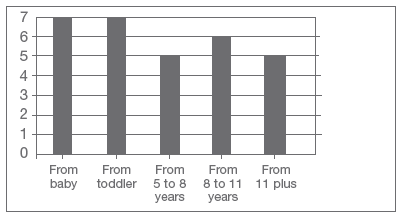
As noted earlier, the length of stay in the placement is striking. One third had been there for the greater part of their childhood, and children who had been placed at the ages of five to 11 had spent at least three years in their placement. Eleven children had had at least one previous episode in foster care and two children had had a previous episode in residential care. In one case, the carers did not initially know about the foster placement and intervened as soon as they found out.
Although some children had previous episodes of residential or foster care, only two moved to their kinship placement directly from foster care. Twenty-seven children (90%) had moved to their placement from their parents' home, and one child had lived with carers from birth.
Who are the children's carers?
Chart 3.5 The relation of the kinship carer to the child
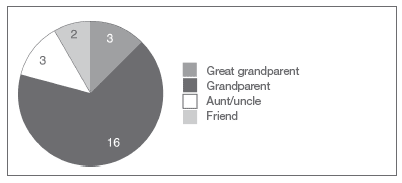
Research in the USA has found that around 50% of kinship carers tend to be grandparents and about a third are aunts (see Hunt 2001). Broad (2001) reports from his study carried out in England that, in a sample of 70 carers, 39% were grandparents, 26% were aunts and the rest were friends. The Northern Irish experience suggests that kinship children are more likely to be placed with a maternal aunt (Lernihan 2003).
In this study, the majority of carers (16) were grandparents, as Chart 3.5 shows. Three carers were great grandparents, two carers were aunts and one was an uncle. Two carers were friends of one of the children's parents. In one case, the friend was a nurse who had cared for the dying mother of the child and gave the child respite care during this time. It was the mother who asked the friend to care for her daughter.
Age of main carers
Chart 3.6 The age of the main kinship carer
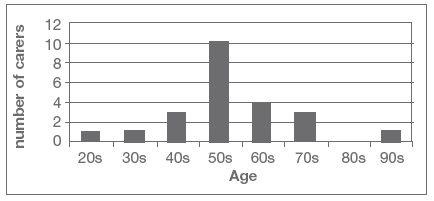
Previous research in the USA and UK has suggested that kinship carers tended to be older than traditional foster carers (O'Brien 2000). As this age distribution shows, the majority of the main carers who were grandparents, were in their fifties. Aunts tended to be younger, with the youngest carer being in her twenties. In this case, the carer was barely beyond her teenage years when two kinship children were placed with her. Most of the older grandparents were lone carers, with the exception of the oldest carer in the study, who had a younger partner.
Structure of household
Half the households were headed by lone carers, two of whom were male, the other half were headed by couples. There were different household structures, some of which were complex. Children were living in a range of households, from those with only one child and the kinship carer (four families), to those where there were several adults and children spanning three generations (12 families). One family housed five of the carers' own children, three of whom were teenagers and two of whom were young adults, as well as the two teenage kinship placement children. Six of the families included an adult son, ranging from 18 to 41 years of age living with their parents or grandparents. Other households comprised carers, their infant children or grandchildren and an older kinship child.
One third of households were located in inner-city areas, with the rest split between peripheral estates and rural areas. Despite the inner-city areas being in areas of high deprivation, in all but two cases the material standard of living was reasonable, with dwellings comfortably furnished and generally well decorated. Several dwellings in two of the city areas had a similar distinctive style of interior décor, based on motifs by Charles Rennie Macintosh. There was evidence of the influence of contemporary fashions in decor, but translated into affordable furnishings. In rural areas, dwellings were more individually furnished, some in contemporary style, some more old fashioned.
Seventeen children had their own rooms. Thirteen shared a room, five of these with other children but eight shared with an adult. Of the eight sharing with an adult, three of these shared with the carer and the other five shared with an adult child of the carer. This situation would clearly not be acceptable in foster care and presented serious problems of overcrowding to the children and families involved. Exceptionally, one child chose to share a room with the carer because the child did not want to sleep alone. About a quarter of families owned their houses and these tended to be in the more rural areas.
Finance
International research suggests that kinship carers are often living on low incomes. One American study (Hegar and Scannapieco 1995) describes kinship care in the USA as 'state sanctioned poverty'. In the UK, several pieces of research have consistently found that finance is a key issue and a serious problem for many families (Flynn 1999, Laws 2001, Richards 2001). One study of grandparent carers reported that:
- 72% had experienced financial hardship as a result of taking on care
- 36% had given up work and 79% reduced their hours
- 17% said their pension rights had been affected
- 15% carried on working but this caused many problems
(Richards 2001, quoted in Hunt 2001 p. 49).
In this study, over half (14) of the 24 households had no earned income, five had one full-time wage (earned by the carer's partner) and five had one part-time wage (four single carer households and one couple household). The rest lived on benefits and pensions, in some cases supplemented by allowances from the social work department for the children. Twenty-two out of 24 families received child benefit for the children while, in one case, the parent still held the child benefit and in the other it had been deducted by the social work department. Around half the households had no consistent payment from social work departments for the kinship care children. Finance was a major issue for kinship carers, as will be shown in Chapter 6.
The subsistence level of income in some families meant the difference between surviving on a daily basis and getting into debt. Families were sometimes at the mercy of decisions made by individuals in agencies. One family, for example, had been told by an official at the social security office that they were eligible for a grant to renovate their house. As a result, the carer had rolled up the carpets and stripped off the wallpaper. When she pursued the grant application further, she was told this had been a mistake. She was left with a chaotic house and no money to proceed with the renovation. There was also an issue for families who moved from one authority to another. In one case, a family had benefited financially by moving to an authority which paid a fostering allowance to all kinship carers of looked after children. Another carer family, who had relied heavily on the financial support of a generous allowance from the social work department, had moved to another authority which offered a minimum grant. The consequences of this was that the family was accumulating debt.
Carer's health
Carers were asked to assess the state of their health. There was considerable variation here, which was not necessarily related to age with one of the youngest carers suffering from M.E. Fourteen of the 24 carers had a long-term illness or disability with diabetes, arthritis and problems associated with heart disease, such as angina, among the most common. There were also several healthy and very active over sixty year olds, however.
Children's health
Chart 3.7 The health of the children

Carers also gave an assessment of children's health. Harwins's study (2001) found that children on care orders in England in kinship placements had very few health deficits. In general, it was the same in this study. Children's physical health was reported to be very good, with 23 children being rated excellent or very good by their carer. The rest were described as reasonable to good. Two children were receiving treatment for mental health problems and one child was receiving treatment for a physical degenerative condition.
The most common problems were asthma and eczema. However, some carers specifically pointed out that children's conditions had improved since their arrival because of the smoke-free environment in which they were now living. We also asked the carers if the child had been hospitalised within the last year. One third had been to see their GP for minor medical problems and a minority of children had been to outpatients with ongoing issues such as eye problems and digestive problems. None of the children had been hospitalised in the previous year due to injuries that occurred in the placement, a finding which concurs with Benedict et al.'s study, which found that children in kinship placements were less likely to be hospitalised because of injury than those in non-related homes (Benedict et al. 1996).
Emotional and behavioural health
A number of research studies have looked at emotional and behavioural problems of children. It is difficult to compare findings, however, because studies have used different measures of 'difficulties or disturbance'. The overall position seems to be that children in kinship care are not without problems but that their problems are less than those in non related foster care (Rowe et al. 1984, Laws 2001, Harwin 2001). The American research has similar findings (Berrick et al. 1994).
In this study, emotional and behavioural development was measured by using Goodman's Strengths and Difficulties Questionnaire (Department of Health, Cox and Bentovim 2000; see also Appendix 1). The questionnaire was completed by 24 of the 30 children. The Strengths and Difficulties Questionnaire explores the emotional and behavioural state of children. The questionnaire is divided into sub sections which explore different aspects of children's emotions and behaviours (see Appendix 1 for details). The scoring has been developed so that roughly 80% of children in the community will have a low need score, indicating they do not have needs in these areas; 10% of children in the community would be expected to have some needs and 10% to have high needs.
Table 3.1 Results of the strengths and difficulties questionnaire
| Low need |
Some need |
High need |
|
|---|---|---|---|
| Total difficulties score |
14 |
5 |
5 |
| Pro-social scale |
24 |
0 |
0 |
| Hyperactivity scale |
15 |
4 |
5 |
| Emotional symptoms scale |
16 |
1 |
7 |
| Conduct problems scale |
19 |
1 |
4 |
| Peer problems scale |
19 |
3 |
2 |
As the table shows, 14 of the 24 children (58%) had a low need on the total difficulties score while 42% of children had either some need or high need. This indicates a higher level of emotional and behavioural problems than would be expected in the general population. On the pro-social scale, all 24 children had a low need score. Cox and Bentovim 2000 suggest that a child who has few problems in relation to pro-social behaviour may be more receptive to help in other areas of their emotional and behavioural problems. The child who is considerate and helpful may also be more adaptable to different parental regimes. The children's score on the pro-social scale in this study is reflected by the positive views of carers on children's co-operative behaviour within the home (see Chapter 6).
A similar proportion of children (62%) showed they had few problems in the area of hyperactivity but there were five children whose hyperactivity indicated they had problems.
One third of children (eight) were exhibiting symptoms on the emotional symptoms scale, which indicates their levels of anxiety. Some of these children were carrying legacies of their past while there was also evidence of these children being very anxious about what was going to happen to them in the future. Four children, who were a serious worry to their carers, were receiving help from professionals (see Chapters 4 and 6).
Three of the five children who scored highly on the conduct problems scale had been in trouble at school or in the community with one child excluded from school and attending a special unit.
Almost 80% of children had low needs in the area of peer problems. This score is echoed in the findings reported in Chapter 4 where the majority of children emphasised the importance of their "pals". Nevertheless, there were five children whose scores indicated that they had needs in relation to peers. This reinforces the findings cited later that several children were experiencing bullying at school.
Children's overall state of well-being
Apart from measuring children's emotional state, carers were asked to give a broad self-assessment of how happy the child was in the placement. With two exceptions carers said that, in their view, children were happy. As Chapter 4 will show, children were also asked to self-assess how happy they were. There was only one case of discrepancy between the carer's opinion and the child's current state of well-being. Here, the carers were acutely aware that the child had many psychological problems because of past experiences and the circumstances with which they were coping heavily influenced their view of the child's state of mind. By contrast, even though the child talked of her problems, it appeared that she was having a good day (see Chapter 4).
Education
All the children in the study were attending school or college. Thirteen children had changed schools when they came to their placements, fourteen had been in their placements since they were infants and the rest had been living sufficiently near their carers to remain at the same school. Subsequently, three children moved schools, one to go to a unit for children with special educational needs, while carers had moved the other two children because they were being bullied.
The study did not assess children's educational attainment through standardised tests but did ask carers and children to make a self-assessment of how children were getting on at school. This is a very blunt measure of educational progress which includes a degree of subjectivity, depending on both children and carer's expectations of what constitutes 'doing well' in children's attainment. Some research, for example, has suggested that kinship carers may underplay children's difficulties (Dubowich 1993; Berrick et al. 1994). Nevertheless, this broad measure does give an indication of children's progress from the perspective of their carer families.
In 22 cases, carers thought children were doing well or very well. In six households, the researchers were shown certificates by both children and carers. The latter were proud of children who were attaining well at school:
Yes, they are all doing well. They get good reports all the time. We've never had a bad report about any of them.
They are both getting very good grades and we are hoping they will go to university.
Missing school had been an issue for many children before they came to their kinship placement and continued to be an issue for four children. One child had missed a whole year of education because of their parent's inability to get the child to school. With the stability and support of the kinship placement, the child was now doing well at school. The carer reported:
She loves school, seems to be well liked and gets on with everybody. I'm pleased with her considering she missed nearly a year of school when she lived with her mum.
As carers indicated, just under a third of children were making slower progress at school. This was often because of poor concentration. This was sometimes attributed to past legacies of the experiences of living with the parents:
He has trouble concentrating. He's always behind and gets into trouble. His problem is he can't take praise.
Truanting was an issue for four children, all of whom were receiving help from schools. There was evidence of good co-operation between carers and schools, as exemplified in this case:
The school are working on him and everybody's in touch with each other. The school knows to call me if there are any problems. The Head rings me if Neil is late or there are any other problems. He's been late a lot when he stays with his mum.
Two children had been moved to special educational units, which carers and children thought helpful (see also Chapter 4). One carer highlighted the individual attention in the unit that was helping the child a lot. Another child was seeing an educational psychologist and was being taxied to school by the social work department.
Five children were being bullied at school and, in two cases, this had necessitated the children being transferred to another school. One carer told us of the horrific treatment a child had suffered, which caused her removal:
She's had nails, bits of wood with nails in it over her head. Eggs thrown at her and it's the stigma as well - "Oh! your mum's a junkie".
In all these cases, as in others where children were having school based problems, schools had been very supportive to children and their carers and were active in protecting children from bullying.
Overall, there was excellent and frequent contact between carers and schools. Carers had taken their parental responsibilities seriously and saw this as important for the children's well-being. Carers attended parents' evenings and supported their children's performances at concerts and school trips. One carer was actively involved with school and had set up a school uniform exchange; another helped establish a school board to improve governance and parent participation.
Carers were also asked about the involvement of parents in children's education. Although many parents had contact with their children and the carer, very few (one third) were involved with their children's education. The rest had occasional contact, which was encouraged by the carers. Sometimes, this depended on their physical and mental state. For example, one carer said:
Their dad is involved [at school] as long as he is off drugs.
How long children would be staying with carers
Studies on kinship care have suggested that the chances of children returning to their parents are lower in kinship care than in stranger foster care. One of the criticisms of kinship care is that there is less impetus for children to be returned or to move to a permanent adoptive home (Maluccio and Ainsworth 1999). On the other hand, kinship care does provide a better chance of permanence than foster care, even if this is by default. However, it could be argued that the long-term placements of kinship care children are a blessing rather than a failing. Kinship care can offer children 'inclusive permanence' (Aldgate 1990), whereby they can be in a continuing planned placement but also retain contact with their parents (see also Chapter 8).
Chart 3.8 Carers' views on how long the child would stay in the placement
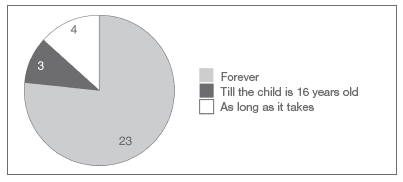
The carers in the study were able to comment on how long they expected the children to stay with them. As Chart 3.8 shows, over two thirds of carers expected that children would stay with them into adulthood. Most of them added that they expected it to be 'forever' and the child was seen as a permanent member of their family. In the case of three children, the carers anticipated that they would be looking after the child until the child reached 16, after which the child would probably return to his or her parents. Carers of the remaining four children hoped they would eventually return home. They told us they thought the children would stay for 'as long as necessary'. It was clear that there was a long-term commitment to the children and that, in the event of carers being unable to continue, the rest of family would continue to look after the child. As Chapter 4 will show, in spite of the clear commitment of carers to the children, this had not always been communicated to the children themselves, who were left feeling uncertain about their future.
The main points
- most children had one living birth parent
- there were different legal routes by which children came to be looked after
- the majority of children came to the placements because of neglect as a result of parents' substance misuse
- there were three different ways by which children came to their placements
- one third of children had been in their placements for a greater part of their childhood
- eleven children had had at least one previous experience in foster care and two children had previous experiences in residential care
- the majority of carers were grandparents
- the average age of carers was 50
- half the households were headed by lone carers of whom two were male and the other half were headed by couples
- over half the carers were living on benefits
- one third of households were located in inner-city areas while the rest were split between peripheral estates and rural areas
- there was considerable variation in the health of the carers which was not necessarily related to age
- in general, children's physical health was reported to be good
- the total difficulties score on the Strengths and Difficulties test for all children indicated that the children had slightly more problems in some areas than would be expected in the general population
- all the children in the study were attending school and doing well
- truanting and bullying were issues for some children
- the majority of carers said the placements were permanent
There is a problem
Thanks for your feedback